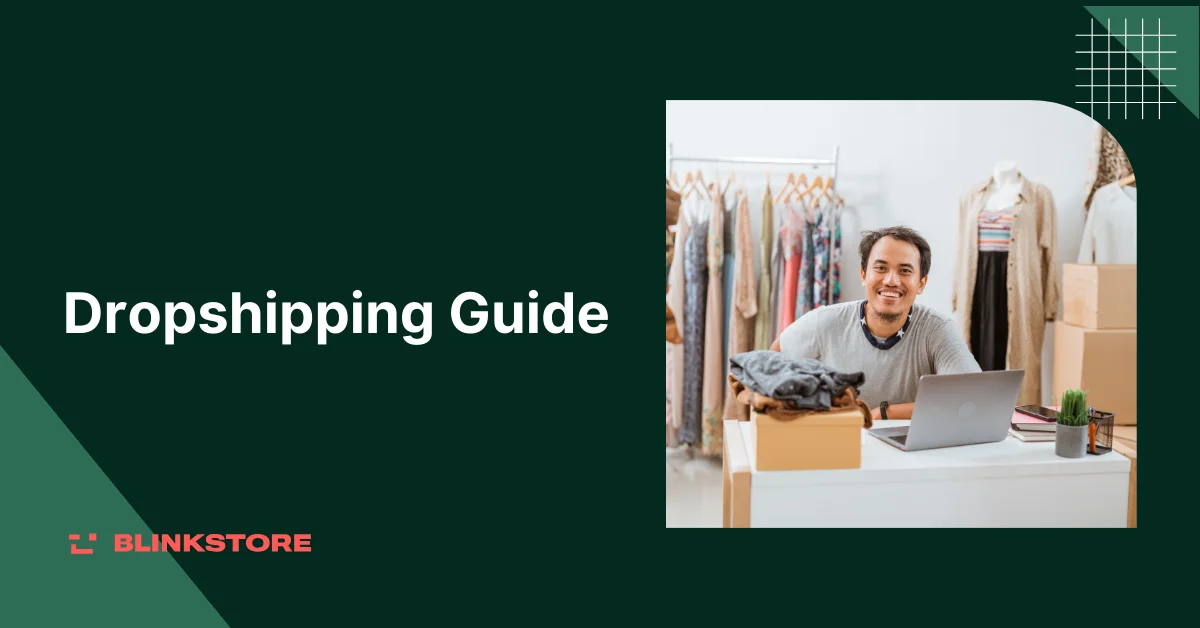Welcome to the ultimate guide of dropshipping! In an age where e-commerce is booming, dropshipping stands out as a lucrative and low-risk way to start your own business. Whether you’re looking to escape the 9-to-5 grind, earn some extra income, or build a full-fledged business, dropshipping can be your gateway.
This complete dropshipping guide will walk you through every step you need to take, from understanding what dropshipping is to launching your store and optimizing it for success. Get ready to dive into the world of dropshipping and discover how you can create a profitable online business with minimal upfront investment.
Table of Contents
What is Dropshipping?
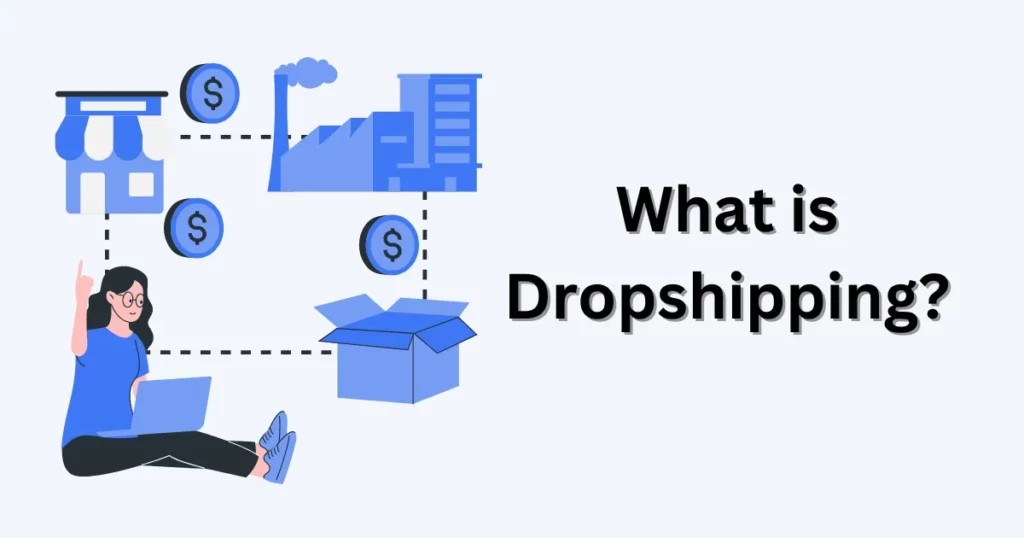
Before we delve into the step-by-step dropshipping guide, let’s clarify what dropshipping actually is. Dropshipping is a business model where the retailer (you) doesn’t keep goods in stock. Instead, a supplier receives an order from a retailer, and the supplier distributes the product straight to the client after receiving the order and payment.
You never deal with the product directly as a result. This model allows you to sell a wide range of products without investing in inventory, making it an attractive option for entrepreneurs.
Also Read: What is Dropshipping
How Does Dropshipping Work?
Dropshipping is a retail fulfillment method where a store doesn’t keep the products it sells in stock. Instead:
- Product Selection: Dropshippers choose products to sell from suppliers without holding inventory.
- Customer Orders: Customers place orders on the dropshipper’s online store.
- Supplier Notification: Dropshipper notifies the supplier, who ships the product directly to the customer.
- Profit Margin: Dropshipper earns profit from the price difference between supplier and retail price.
- Scale and Growth: Scalability is key as dropshippers can expand product offerings without physical warehousing.
Start a Print-on-Demand Dropshipping Business Today!
Advantages and Disadvantages of Dropshipping
Advantages:
- Low Startup Costs: You don’t need a lot of money to start since you only buy products after a customer orders and pays for them, which reduces financial risk.
- Wide Product Selection: You can offer a diverse range of products without having to buy them in advance. This flexibility allows you to adapt to market trends and customer preferences quickly.
- Location Independence: Since you don’t need to manage physical inventory, you can run your dropshipping business from anywhere with an internet connection. This makes it ideal for digital nomads or anyone looking for the freedom to work remotely.
- Scalability: Dropshipping makes it easier to scale your business compared to traditional retail. As your sales grow, you won’t need to worry about storage space or managing inventory, allowing you to focus on marketing and customer service.
Disadvantages:
- Lower Profit Margins: Due to high competition in the dropshipping market, pricing can be very competitive, often leading to lower profit margins. You need to sell higher volumes to achieve significant profits.
- Inventory Issues: Since you rely on suppliers to maintain inventory, you can face stockouts and inventory issues that are out of your control. If a supplier runs out of stock, it can delay your order fulfillment and affect customer satisfaction.
- Shipping Complexities: Working with multiple suppliers can lead to complicated shipping processes. Different suppliers may use different shipping methods and charge varying rates, which can result in inconsistent delivery times and increased shipping costs.
- Less Control: Dropshipping limits your control over various aspects of the business, including product quality, packaging, and shipping times. Poor supplier performance can negatively impact your brand’s reputation and customer satisfaction.
Step-by-Step Dropshipping Guide
Each step in this dropshipping guide is meant to give you the knowledge and tools necessary to create a successful online store. Whether you’re new to entrepreneurship or have experience, following these steps will help you handle the challenges of dropshipping and set you up for success in starting your own business.
Step 1: Choose Your Niche

Choosing the right niche is the foundation of a successful dropshipping business. A niche refers to specializing in a specific market segment or products to target particular groups of customers effectively. While choosing a dropshipping niche, consider the following factors:
- Identify Your Interests and Passions: Begin by listing areas you are passionate about.
- Research Market Demand: Use tools like Google Trends, keyword research, and market research reports to gauge demand for your chosen niche. High demand indicates a healthy market with potential customers.
- Analyze Competition: Investigate other dropshipping stores in your niche. While some competition is a good sign of a profitable niche, too much competition can make it difficult to stand out.
- Evaluate Profitability: Ensure that the products in your niche have a good profit margin. Calculate the potential selling price, subtracting costs like product price, shipping, and marketing.
Step 2: Conduct Market Research
Conducting thorough market research is crucial for understanding your target audience and the competitive landscape. This step in our complete dropshipping guide involves:
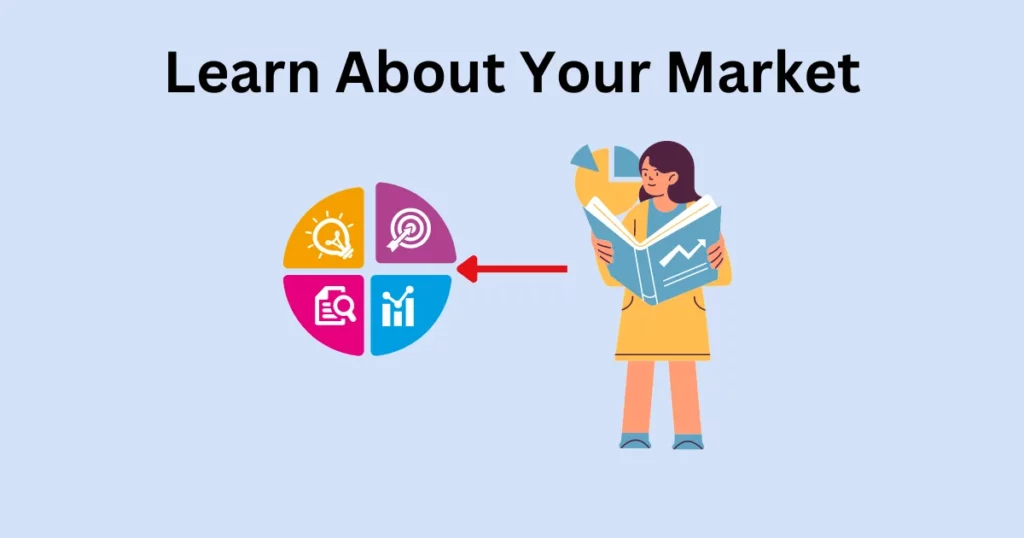
- Understanding Your Target Audience: Define who your ideal customers are, their demographics, interests, and buying behaviors. Knowing your audience helps tailor your marketing efforts and product selection.
- Analyzing Competitors: Examine your competitors’ websites, their product range, pricing, and marketing strategies.
- Identifying Trends: Stay updated on trends in your niche by following industry news, social media, and market research reports.
With detailed market research, you can make informed decisions and position your dropshipping store for success.
Step 3: Find the Best Dropshipping Products
Finding the best dropshipping products is crucial for your store’s success. Here are some tips to help you identify winning products:
- Use Product Research Tools: Utilize various tools to find popular and trending products in your niche.
- Analyze Market Trends: Monitor emerging trends and seasonal products to stay ahead.
- Customer Feedback and Reviews: Review customer feedback to understand their preferences and needs.
Step 4: Find Reliable Suppliers
A dropshipping business heavily depends on reliable dropshipping suppliers. Here’s how to find and evaluate them as suggested in our Dropshipping guide:
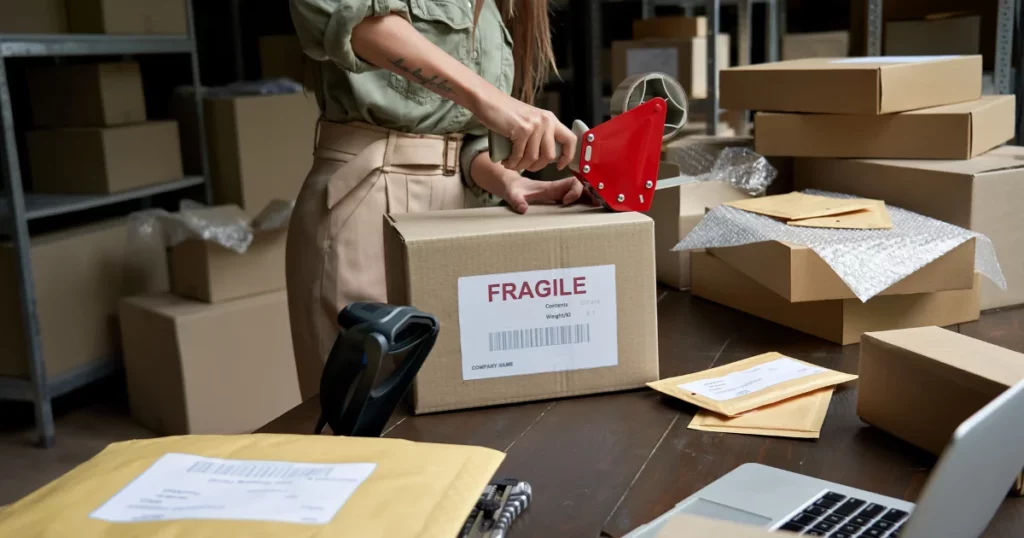
- Use Supplier Directories: Websites like AliExpress, and Oberlo offer lists of verified suppliers. These platforms make it easier to find reputable suppliers and compare their offerings.
- Contact Manufacturers: Reach out to manufacturers directly to see if they offer dropshipping services. This can sometimes result in better pricing and more reliable supply chains.
- Order Samples: Always order samples from potential suppliers to check the product quality, shipping times, and overall service. This step helps ensure you’re offering high-quality products to your customers.
Selecting the right suppliers can make or break your dropshipping business, so take the time to research and choose wisely.
Step 5: Set Up Your Online Store
Setting up your online store is a critical step in bringing your dropshipping business to life. Here’s how to do it:
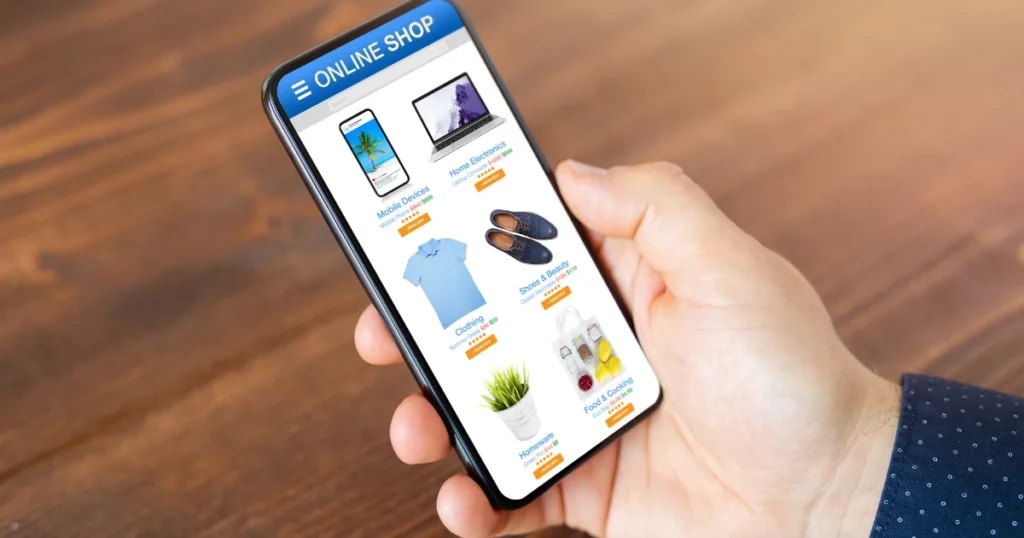
- Choose an E-commerce Platform: Selecting the right e-commerce platform is crucial for your store’s success. Explore options that fit your business needs. For a comprehensive list, check out our article on Top E-Commerce Platforms in India.
- Design Your Store: Customize your store’s appearance to create a unique and engaging shopping experience for your customers.
- Add Products: Import your products from suppliers, complete with detailed descriptions, high-quality images, and competitive pricing. Ensure each product listing is optimized to attract customers and encourage purchases.
- Set Up Payment Methods: Ensure you have secure and convenient payment options for your customers.
By following these steps, you can create an attractive and functional online store that appeals to your target audience.
Step 6: Optimize Your Store for SEO
Effective SEO strategies attract more organic traffic. Here’s how:
- Keyword Research: Identify keywords relevant to your products and niche.
- On-Page SEO: Optimize product titles, descriptions, and images with your target keywords.
- Content Marketing: Start a blog to publish valuable content related to your niche. This will help drive traffic, build authority, and improve your SEO.
- Technical SEO: Ensure your website loads quickly, is mobile-friendly, and has a secure HTTPS connection.
Step 7: Implement Effective Marketing Strategies
Effective marketing strategies in the ultimate guide to dropshipping start with building a strong online presence. Here are some strategies to consider:
- Social Media Marketing: Use platforms like Instagram, Facebook, and Pinterest to promote your products and engage with your audience. Share content regularly and interact with your followers to build a loyal customer base.
- Influencer Marketing: Collaborate with influencers in your niche to reach a wider audience. Influencers can help you build trust and credibility with potential customers.
- Email Marketing: Build an email list and send newsletters, promotions, and product updates to your subscribers.
- Paid Advertising: Invest in Facebook Ads, Google Ads, and other paid advertising platforms to boost your visibility and drive targeted traffic to your store.
A well-rounded marketing strategy can help you reach more customers and grow your dropshipping business.
Step 8: Manage Orders and Customer Service
The next step in this dropshipping guide is to manage orders and customers. Efficient order management and excellent customer service are crucial for your dropshipping business. Here’s what to do:

- Automate Order Processing: Use tools that automate order processing and tracking.
- Provide Excellent Customer Support: Respond promptly to customer inquiries and resolve issues effectively.
- Monitor Inventory: Keep track of your suppliers’ inventory to avoid stockouts. Communicate regularly with your suppliers to stay updated on product availability.
By managing orders efficiently and providing great customer service, you can build a strong reputation and loyal customer base.
Step 9: Analyze and Optimize
The final step in this step-by-step dropshipping guide is analyzing your performance and optimizing your operations. Here’s how:
- Track Key Metrics: Monitor sales, traffic, conversion rates, and customer satisfaction to understand your store’s performance.
- Use Analytics Tools: Utilize tools like Google Analytics to gain insights into your store’s performance.
- Optimize Marketing Campaigns: Continuously test and refine your marketing strategies for better results. Experiment with different ad creatives, targeting options, and marketing channels.
- Expand Your Product Range: Introduce new products based on customer feedback and market trends.
As described in this step-by-step dropshipping guide, regular analysis and optimization are essential for maintaining and growing a successful dropshipping business.
Start a Print-on-Demand Dropshipping Business Today!
How to Start Your Dropshipping Business with Blinkstore
Starting your dropshipping business with Blinkstore can simplify many aspects of the process. The process is straightforward if you follow these steps of complete dropshipping guide:
Step 1: Sign Up for Blinkstore
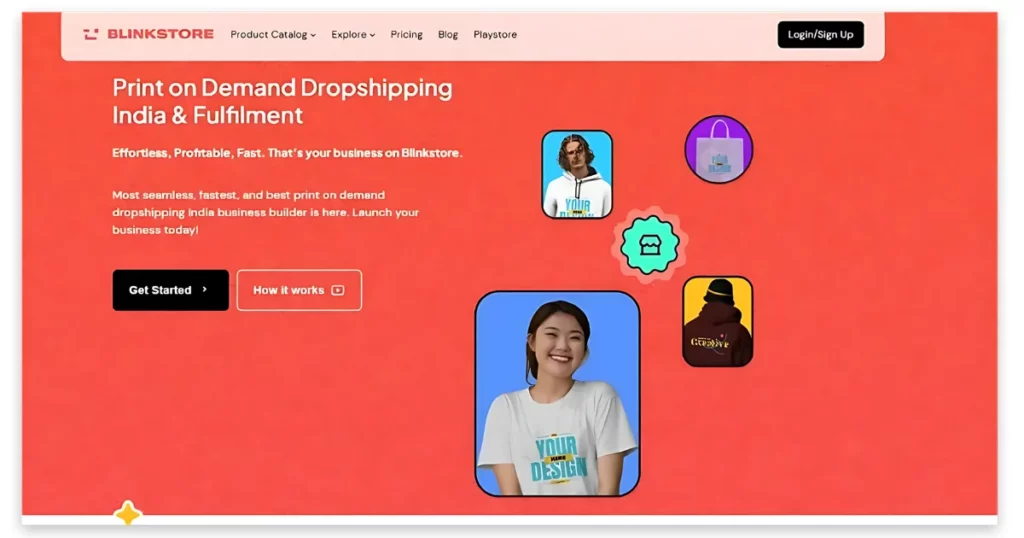
Visit the Blinkstore website and create an account. Begin by visiting the Blinkstore website and creating an account. Provide the necessary information, such as your email address and a secure password, to get started. Once you’ve created your account, you’ll have access to Blinkstore’s dashboard, where you can manage your store, products, and orders.
Step 2: Choose Your Products
Browse Blinkstore’s extensive catalog to select products you want to sell. Blinkstore offers a variety of high-quality products across different categories, from fashion and accessories to electronics and home goods. Take your time to choose products that align with your niche and appeal to your target audience.
Step 3: Set Up Your Store
Blinkstore provides easy-to-use tools to set up your store. Here’s how:
- Choose a Theme: Blinkstore offers a range of customizable themes that you can use to design your store. Select a theme that fits your brand and create a professional, user-friendly website.
- Customize Your Store’s Appearance: Use Blinkstore’s design tools to customize your store’s look and feel. Add your logo, choose your color scheme, and arrange your product listings to create an attractive shopping experience.
- Add Products: Import the products you’ve chosen from Blinkstore’s catalog. Ensure each product listing includes high-quality images, detailed descriptions, and competitive pricing.
Setting up your store with Blinkstore is simple and efficient, allowing you to focus on growing your business.
Step 4: Integrate Payment Methods

Blinkstore supports multiple payment gateways. Choose the ones that best suit your target audience and integrate them into your store. Setting up secure and convenient payment methods ensures a smooth checkout experience for your customers.
Step 5: Launch Your Store
Once everything is set up, it’s time to launch your store and start promoting it. Here’s how:
- Test Your Store: Before launching, test your store thoroughly. Make sure all links work, products are correctly listed, and the checkout process is smooth.
- Announce Your Launch: Use social media, email marketing, and other channels to announce your store’s launch. Create excitement and attract your first customers with special promotions or discounts.
- Monitor Your Store: After launch, keep an eye on your store’s performance. Track traffic, sales, and customer feedback to identify any issues and opportunities for improvement.
Launching your store with Blinkstore is just the beginning. Continuous marketing and optimization are key to building a successful dropshipping business.
Step 6: Manage Orders
Blinkstore automates order processing and fulfillment. When a customer places an order, Blinkstore handles the shipping, ensuring timely delivery. Here’s what to do:
- Monitor Orders: Use Blinkstore’s dashboard to monitor incoming orders and track their status.
- Communicate with Customers: Keep customers informed about their order status. Send confirmation emails, shipping notifications, and tracking information to enhance their shopping experience.
- Handle Returns and Refunds: Have a clear policy for returns and refunds. Handle these efficiently to maintain customer satisfaction and trust.
Efficient order management is essential for delivering a positive customer experience and building a reputable dropshipping business.
Step 7: Provide Customer Support
Ensure you provide excellent customer support. Blinkstore’s platform includes features to help you manage customer inquiries and issues efficiently. Here’s how:
- Set Up a Help Desk: Use Blinkstore’s customer support tools to set up a help desk. Provide clear contact information and respond to inquiries promptly.
- Create a FAQ Section: Anticipate common customer questions and create a comprehensive FAQ section on your website. This can help reduce the volume of inquiries and provide quick answers to customers.
- Maintain Professionalism: Always communicate with customers in a professional and courteous manner. Address their concerns effectively and strive to exceed their expectations.
Providing excellent customer support can lead to positive reviews, repeat business, and a loyal customer base.
Step 8: Analyze Performance
Use Blinkstore’s analytics tools to track your store’s performance. Here’s how:
- Monitor Key Metrics: Track sales, traffic, customer behavior, and other key metrics to understand store’s performance.
- Identify Trends: Look for trends in your sales and customer feedback. Identify popular products, peak shopping times, and other patterns that can inform your marketing and product strategies.
- Optimize Your Store: Based on your analysis, make necessary adjustments to your store, marketing campaigns, and product offerings. Continuous optimization can help you stay competitive and grow your business.
By regularly analyzing your performance and making data-driven decisions, you can maximize your store’s potential and achieve long-term success.
Conclusion
This complete dropshipping guide has covered all the essential steps you need to take to start a successful dropshipping business. From choosing a niche to setting up your store and implementing effective marketing strategies, each step is crucial for your success. Remember, dropshipping requires dedication, continuous learning, and optimization. By following this step-by-step dropshipping guide, you’ll be well on your way to building a profitable online business. And with platforms like Blinkstore, the process becomes even more streamlined and efficient. Happy dropshipping!
FAQs on Dropshipping guide
What marketing strategies work best for dropshipping?
Effective marketing strategies include social media marketing, influencer marketing, email marketing, and paid advertising on platforms like Facebook and Google.
How do I handle returns and refunds in a dropshipping business?
Set clear return and refund policies, communicate them to your customers, and work with your suppliers to manage returns and refunds efficiently.
How can I optimize my dropshipping store for SEO?
Optimize your store for SEO by conducting keyword research, optimizing product titles and descriptions, creating valuable content, and ensuring your website is fast, mobile-friendly, and secure.
Is Dropshipping profitable in India?
Yes, dropshipping can be profitable in India. With the right niche, effective marketing strategies, and reliable suppliers, you can build a successful dropshipping business. The growing e-commerce market in India offers ample opportunities for dropshippers.
Is Dropshipping legal in India?
Yes, dropshipping is legal in India. It operates under standard business laws. However, you must comply with all regulations, including tax laws and consumer protection regulations, to run your dropshipping business legally.
Related Articles:
